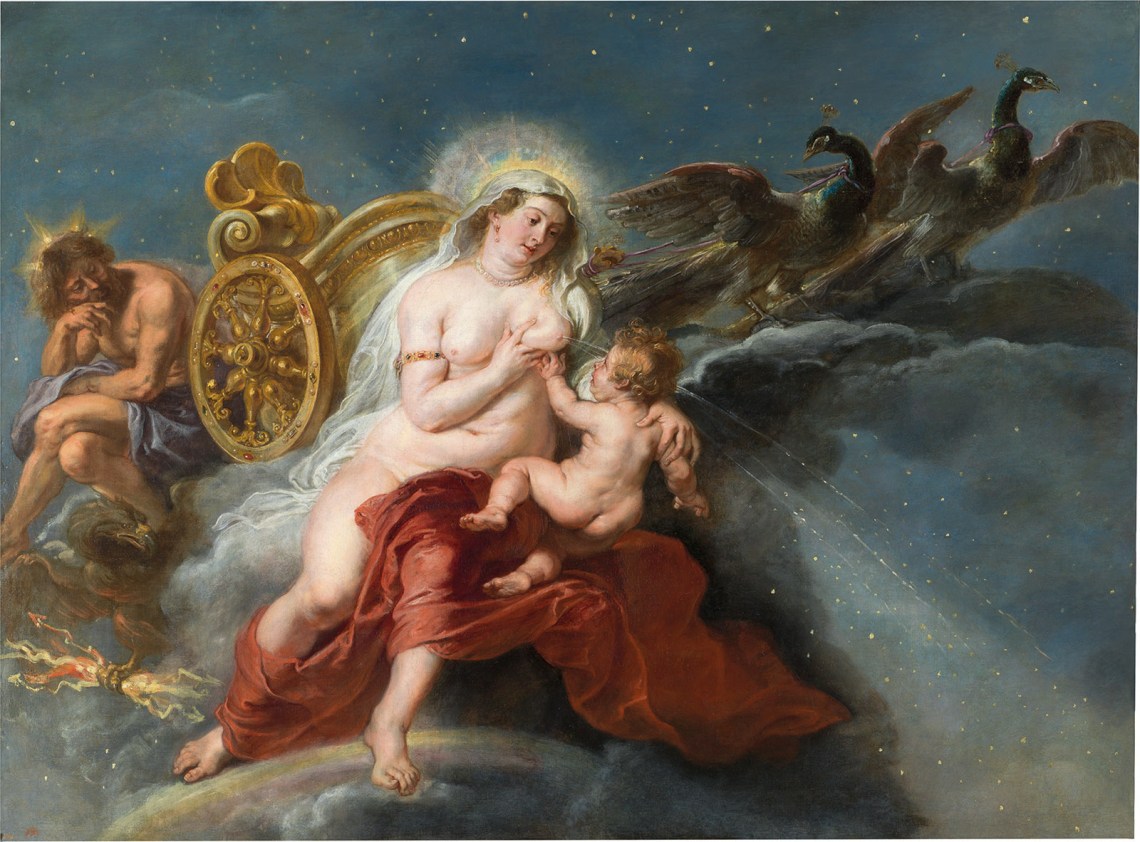Four canvases, each at least bedsheet size, hang in a compact box of a gallery. The low, absorptive blue of its walls echoes the colors just inside the gilt frames. But further within, big figures have been modeled in warm brown brushwork, and additions of white paint, rose- and ocher-tinted, thrust the flesh of these bodies forward to dominate the room. The gold leaf and the grandiose nudity signal to me a certain yesteryear—that of old, stately Europe. Is it because these signals crowd so close that I feel restless?
The Dulwich Picture Gallery in South London, opened to the British public in 1817, has since served, thanks to the old masters bequeathed it, as a window onto that world of the grandees. Now it has drawn on its holdings by Peter Paul Rubens to mount an exhibition on the theme of women in his work, uniting them with international loans. From Dresden comes Diana Returning from the Hunt, over six feet wide and painted perhaps around 1623 for Archduchess Isabella, who then ruled Flanders. From the Prado comes the over-seven-feet-high Three Nymphs with a Cornucopia, presented to King Philip IV of Spain in 1628, and The Birth of the Milky Way, over eight feet wide, one of a sequence painted for the king’s hunting lodge some ten years later. This joins Dulwich’s Venus, Mars and Cupid, a slightly earlier, portrait-format composition with closely related imagery.
They each pine for their palaces; that is partly why I shuffle. Reinstall them in spacious state rooms, and the allegorical intentions about which the curators’ captions inform me—how, for instance, a putto unbuckling Mars’s armor in the Dulwich painting slyly chides the hawks who were driving forward the Thirty Years’ War—might just fall into place. But penned as they currently are, these mighty beasts of the past feel overbearing. The Dresden picture features three satyrs—grinning rustics, horned and horny, who hope to make out with Diana’s accompanying huntswomen. Ribaldry is presumably the agenda, but how am I to grin back at caricatures of “earthy simplemindedness” that are so archly condescending? Comedy, this time of male comeuppance, is likewise scripted into The Birth of the Milky Way, in which Jupiter, having asked his wife to nurse his bastard son Hercules, is put out of joint when Juno refuses, instead jetting out milk from her plump left breast to streak across the broad night sky. But the sheer weight and scale of the figures’ umber and lead-white modeling banish any light humor. Moving my eyes between the rejected, tumbling baby here and a comparable Cupid who, in the Dulwich picture, struggles to feed from his archly simpering mother Venus, I likewise lose my footing. If I am tempted to laugh, it is at, not with.
But yes, that reaction is gender-inflected, and gender is historically unstable. To picture, as Rubens does, a near-life-size woman directing her breast milk scattershot and wide—much as a boy might swaggeringly piss—is at once to uphold a lofty notion of the feminine, with all that implies of generativity and indeed galaxy creation, and to recognize that women are free agents. Rubens affirms their autonomy while yet ascribing to them an ordained role in nature. We might tilt that conjunction otherwise today—might be readier with the affirmation, more equivocal about the ascription. Here lies the implicit challenge that the curators have set themselves in mounting an exhibition entitled “Rubens and Women.” Bringing together those four canvases along with many other slighter items—portraits, drawings from models or from medals, studies for altarpieces or salvers—in order to pack Dulwich’s tight exhibition galleries, can the curators bend contemporary eyes and hearts toward the sexual sensibilities of Counter-Reformation Europe’s most capacious and intellectually assured artist?
There is a preliminary problem. Conservatism in cultural affairs is apt to come across either as a cornered or a complacent stance. Yet conservatism is salient if we think about Rubens; it has had no more articulate advocate. The man combined formidable personal probity with a devotion—demonstrated by various exhibits at Dulwich—to Catholic cults of the Virgin and other female saints. Through a career begun in 1590s Antwerp, expanded by eight years’ service for an Italian patron, then rising after his return north in 1608 to an ever loftier and more international scale of operation, the painter glamorized potentates, undertook political missions at their dictates, and propagandized (as with that Mars and putto allegory) for a peaceable status quo ante that he hoped in vain they would uphold. The same will to reconciliation governed his studio practice, which drew both on the great Renaissance masters and on recent innovators such as Caravaggio to forge an imposing stylistic synthesis. All that, however, seems oblique to our current concerns. The kinds of honor that Rubens paid to virgin martyrs, to Archduchess Isabella or Marie de’ Medici, regent of France—here observed in a sketch from life as a grim and haughty dowager, afterward to be glorified in an extensive sequence of palace canvases—are only in the very loosest sense feminist.
Advertisement
But there is another confusion that could arise. Rubens has long been renowned for his promotion of a female body type that is pale-skinned and generously fleshy, and this touches on prejudices that may be peculiarly white European. When the Harvard psychologist William Sheldon coined the term “endomorph” in 1942 for a supposed sector of humanity whose rounded bodies paralleled their “relaxed” and “tolerant” temperaments, he was falling in with stereotypes at least as old as Shakespeare’s Julius Caesar—the dictator fearful of the lean man who “thinks too much” and wishing instead for “men about me that are fat.” The inference—that corpulence approximates to passivity—might lead one to suppose that Rubens was painting women as sex objects, with the same condescension he applied to those gormless satyrs. But as the Milky Way’s Juno demonstrates, Rubens did not exactly buy that inference.
His synthesizing instincts acted against it: his study while in Italy of Leonardo and Michelangelo led him to treat bodies as flows of energy that course into multiple entangled channels, an analysis he meant to fuse with the hot sensual charge of Titian’s brushwork. The Rubensian flesh shimmers, ripples, and forms eddies—and it is not the preserve of one sex alone. The Dresden Diana and the foremost of those satyrs are matchingly strong-shouldered—both figures probably informed by study of the same male model, just as in an exhibited sketch a young man is seen posing for a picture of the mythological maiden Psyche. Sexual difference remains: males are color coded ruddy, females as gleaming white, but they are envisaged as yin and yang, rather than as superior and subaltern.
Besides, as a catalog essay relates, personal experience had taught Rubens that muscle mass did not equate to power. A remarkable letter from his mother to his father—a lawyer who was imprisoned after straying into adultery with the princess who employed him, and whom Rubens’s mother now wrote to forgive—suggests which of his parents had the greater force of character. Isabella Brant, the haute bourgeoise whom Rubens at thirty-two took for his wife, likewise comes across in a touching portrait, painted soon after her death some seventeen years later, as at once compassionate and commanding. Males are at some points foolish, at others pitiful, in pictures often devised for female grandees: from the wrongfooted Jupiter and Mars to the sad corpses, in smaller panels elsewhere, of Jesus and Adonis, each overshadowed by mourning women.
No neat conclusion can be drawn, given that lives are not argument-shaped. At fifty-three Rubens took for his second wife Helena Fourment, a sixteen-year-old connected by family to Isabella and likely known to him from infancy. She bore him five children and also became the model—or at least the inspiration—for a profusion of buxom, broad-hipped blondes painted during the ten years that remained to the painter, including the aforementioned Venus and Juno. Dulwich has not secured from Vienna’s Kunsthistorisches Museum the most famous piece, the so-called Het Pelsken (The Fur, circa 1636–1638) that shows Helena nude except for a fur coat clutched to her middle, but a polished red-and-black chalk drawing of her from the Louvre is no less naked and intimate. How close are we here to the notorious November-and-April relationship of Picasso and Marie-Thérèse, with its sharp savor of scandal? Rubens, unlike that other prodigious celebrity, appears to have kept his sex life within the bonds of marriage. Yet here too was a conscious, because-I-can experiment by a painter already occupying a plateau of achievement, co-opting a fresh young human vehicle to drive his imagination onward.
Since no clear moral follows, we fall back to consider the singularity of a life. Or more exactly, at Dulwich, the variousness of an artist’s production. The shouty canvases made for palaces are preceded by quiet, tender panels such as The Virgin in Adoration Before the Christ Child (circa 1616–1619), for which Rubens studied Isabella, one of their little boys, and the blanket from his cot. (He liked to reconcile archetypal stories with contemporary specifics, so that while two of the Prado Cornucopia nymphs are classically nude, the third sports a glam headscarf and a dress of purple silk.) Terse chalked notations of poses accompany presentation drawings of exquisite preciousness: finicky penwork, selecting knots of figures from Mannerist reliefs, is displayed alongside a reverential interpretation of Michelangelo’s Night.
The show’s opening gallery, featuring portraits, shows how Rubens could modulate his accents from close and sober—a heart-stopping oil study of his thoughtful young daughter—to obsequious and slick. The latter, notably, comes in a salute to a Genoese marchesa painted in his late twenties, matching the scale of the later grand nudes but wildly dissimilar in facture. By including a large and quaintly Flemish Adam and Eve, painted before Rubens had ever set foot in Italy, the curators risk, I feel, the reduction of their theme to inconsequence. Women, to judge by this, could mean anything at all, and so could Rubens.
Advertisement
Yet as it happens there is, among the sundry artistic personas encompassed in Rubens’s career, at moments a kind of modernist. At Dulwich he emerges in a couple of smallish panels. A modello for an arched altarpiece for Antwerp’s cathedral is stoutly Counter-Reformation in subject: to the amazement of her mourners, a revived Virgin, released from her tomb, soars up to heaven, thronged by putti and angels. But in this Ascension sketch the fusion of mass with space, together convulsed by a switchback surge of energy, would thrill any Futurist. Inertia is abolished. The rush has its from and its to—the tomb’s dark mouth and the upper semicircle of celestial light—yet these matching, echoing forms stand nakedly as pigment: so much burnt umber, so much lead white. A miracle of Catholic dogma thus becomes an aesthetic miracle, at once transcendent and wholly self-contained.
Another studio reverie posits a trinitarianism of art, picturing those fluid allegories of the desirable, The Three Graces (circa 1636). Their elastic rotating dance gets stamped into the panel’s warm priming with the nervy curlings of a fine-tipped brush and the scumbles of a coarser one, the figures in this way creating the never-never land we glimpse behind them and proclaiming the existence of form where all had been merely latent. “If it is possible to sum up, in one work, the way that Rubens respected the beauty of women, then this is it,” writes Jennifer Scott, the gallery’s director—one might add that it is equally a hymn to the beauty of oil paint. We can forever learn from Rubens about the latter. I am less sure whether he tells us how women and men should relate.
This Issue
January 18, 2024
Tools to End the Poverty Pandemic
Across the Moominverse




